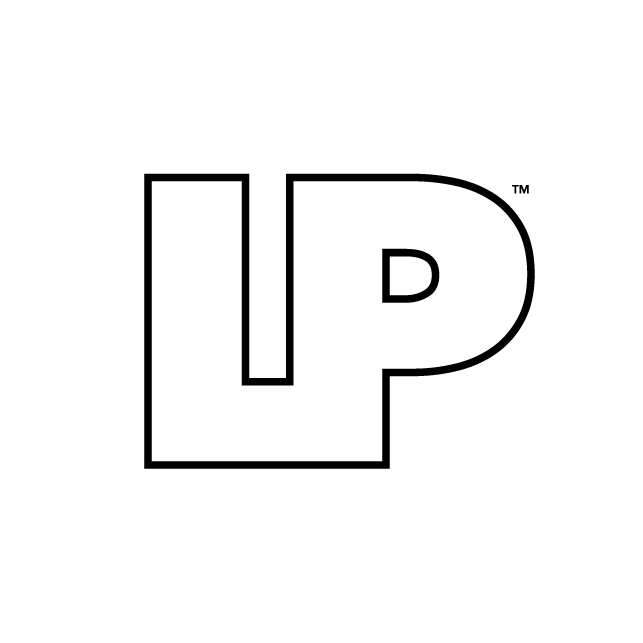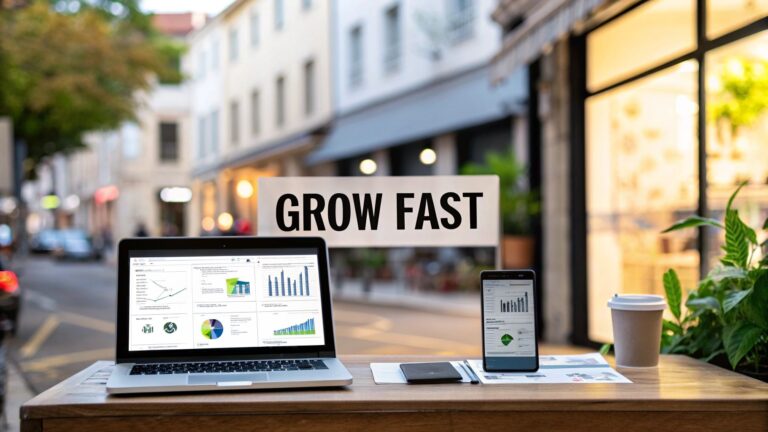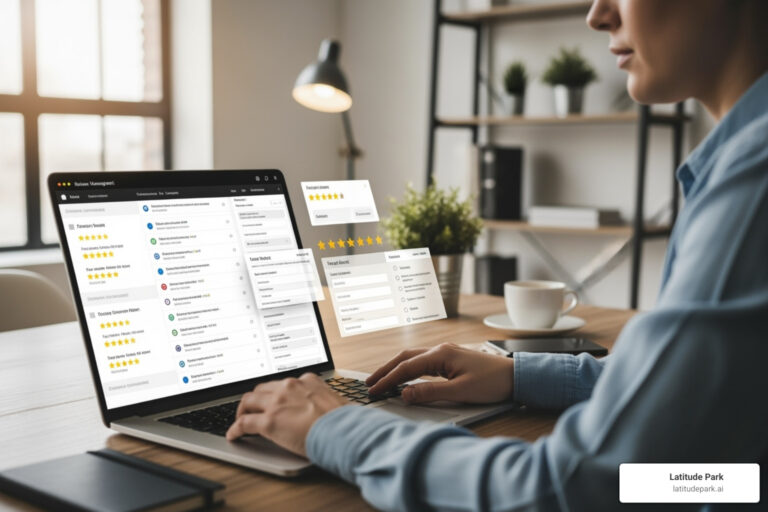Learning how to advertise a small business isn't about throwing money at ads and hoping for the best. It's a calculated process. The formula I've seen work time and time again is simple: define clear goals, get to know your customer inside and out, and then—only then—set a realistic budget.
Nail these three things, and every campaign you launch will have a fighting chance from day one.
Build Your Advertising Foundation First
Jumping straight into creating ads without a plan is like building a house on sand. You might see a little flurry of activity, but it’s a setup for failure. To make every dollar count, you have to build a solid foundation first.
This isn’t about guesswork. It’s about making deliberate, informed decisions that will guide your entire strategy. Before you even think about which ad channels to use, it's critical to understand the core idea of marketing, which is the bedrock of any ad campaign that actually works.
This foundational work comes down to three key areas: setting your goals, defining your audience, and establishing your budget.
Set Specific and Measurable Goals
Vague goals like "get more customers" are impossible to measure and, honestly, a waste of time. You need a finish line. That’s where the SMART goal framework (Specific, Measurable, Achievable, Relevant, Time-bound) comes in handy.
Let’s look at a real-world example:
- A bad goal: "I want to grow my business."
- A SMART goal: "Acquire 50 new leads through local search ads in Q2 with a cost per lead under $25."
See the difference? The second one gives you a clear target. It tells you exactly what success looks like, making it easy to see if your advertising is actually delivering. Another practical example for an e-commerce store might be: "Increase online sales of our new product line by 15% in the next 30 days using a targeted Instagram ad campaign." This goal is specific, measurable, and has a clear deadline.
Create Detailed Customer Personas
You can't talk to everyone, so you need to know exactly who you're talking to. This is where customer personas—fictional profiles of your ideal customers—become invaluable. And I mean going way beyond basic demographics.
For instance, a local coffee shop might be targeting "Freelance Writer Fran." She's 28, values a quiet atmosphere, needs reliable Wi-Fi, and appreciates a good specialty coffee. Knowing this, the coffee shop can run a Facebook ad campaign targeting people with "Freelancer" as a job title who live within a 2-mile radius, using ad copy like "Your quiet corner to write the next great chapter. Free Wi-Fi and bottomless coffee until 2 PM."
On the other hand, a B2B IT service might focus on "Small Business Owner Steve." He's 45 and is far more concerned with data security, system uptime, and predictable costs. Knowing the difference between Fran and Steve ensures your ad copy, visuals, and channel choices will actually resonate with the right people.
This visual shows how you can move from identifying your audience to picking the right channels to reach them.
The key takeaway here is that understanding customer pain points is the bridge between knowing who your customers are and deciding where to find them.
Establish a Realistic Advertising Budget
Finally, you need to figure out what you can realistically spend. For established businesses, a common starting point is the percentage-of-revenue model.
In 2024, many small businesses are allocating between 7% and 10% of their annual revenue to marketing and advertising. So, if your business generated $300,000 in revenue last year, a reasonable starting budget would be between $21,000 and $30,000 for the year, or roughly $1,750-$2,500 per month. This isn't just an expense; it's a strategic investment in growth. That budget allows them to focus on high-impact channels like local SEO and social media instead of spreading their money too thin.
A realistic budget isn't just a number; it's a strategic tool. It forces you to prioritize high-impact activities and prevents wasteful spending on channels that don't align with your goals or audience.
Before you jump into choosing specific platforms, it helps to see how the most common channels stack up for different types of small businesses. This table breaks down where you might want to focus your initial budget based on your goals.
Advertising Channel Suitability for Small Businesses
| Channel | Best For | Typical Cost | Key Advantage |
|---|---|---|---|
| Google Search Ads | Capturing immediate, high-intent customers actively looking for a solution. | Pay-per-click (CPC) model; can range from $1-$50+ per click. | You reach people at the exact moment they need you. |
| Meta (Facebook & Instagram) Ads | Building brand awareness and targeting specific demographics and interests. | Pay-per-impression (CPM) or CPC; often lower cost than Google. | Excellent for visual products/services and community building. |
| Local SEO & Google Business Profile | Driving foot traffic and attracting customers in a specific geographic area. | Primarily time and effort, though you can hire experts. | High trust factor and targets the most relevant local audience. |
| Local Print & Radio | Reaching an older, less digitally-native demographic in a concentrated area. | Can be expensive; often sold in packages. | Great for building local brand recognition and credibility. |
This table is just a starting point. The best choice always comes back to your specific goals, audience, and budget. Once you have those foundational elements locked in, you'll be in a much stronger position to pick the right channels and create campaigns that deliver real results.
Choosing Your Digital Advertising Channels
With your foundation solidly in place, it’s time to decide where your ads will actually live. The digital world is a noisy place, but you don't need to shout everywhere. The goal is to show up in the right places—wherever your ideal customers are already spending their time or actively searching for answers.
The great news for small businesses is that digital platforms have really leveled the playing field. You don’t need a Super Bowl-sized budget to compete anymore. This shift is huge, and global trends back it up; projections show worldwide ad spending will cross $1 trillion for the first time in 2025, and over 75% of that will be digital. This massive investment proves just how powerful and accessible online channels have become. Learn more about global ad spend trends on abbeymecca.com.

Capture High-Intent Customers with Google Ads
There's a reason Google Ads is the first stop for so many businesses: it puts you directly in front of people at the exact moment they’re looking for what you offer. You’re not interrupting their day; you’re being the solution they’re actively trying to find.
Think about a local plumber. When a pipe bursts at 2 AM, the homeowner isn't casually scrolling through Instagram. They’re grabbing their phone and frantically searching "emergency plumber near me." A well-placed Google Ad can put that plumber at the very top of the results, capturing a valuable lead in seconds. That plumber might bid on keywords like "24-hour plumber Dallas" or "leaky pipe repair" to ensure their ad only shows to people with an urgent problem.
This intent-based advertising is incredibly powerful for service businesses, local shops, and e-commerce stores alike. You bid on the specific keywords your customers are typing into the search bar, making sure your ad budget is spent on people who are ready to make a move. To really dial this in, check out our complete Google Ads for local business guide.
Target Specific Audiences with Paid Social Ads
While Google is fantastic for capturing active searchers, platforms like Meta (Facebook and Instagram) and LinkedIn let you find potential customers before they even realize they need you. This is discovery-based advertising, and its real magic lies in its laser-focused targeting capabilities.
Imagine you run a small business that creates bespoke jewelry. With Instagram Ads, you could target users who have shown interest in "engagement rings," follow popular wedding accounts, and live in specific high-income zip codes. An ad featuring a stunning video of a custom ring can then pop up right in their feed, sparking that initial desire and driving them straight to your site. This is a practical way to create demand rather than just capturing it.
Social media advertising lets you build an audience from the ground up based on demographics, interests, and online behaviors. It’s perfect for visual products, building brand awareness, and reaching those niche markets that are tough to find through search alone.
Build Long-Term Assets with SEO and Content Marketing
Paid ads are fantastic for getting quick results, but they have one major drawback: they stop working the second you turn off the spending. That's where Search Engine Optimization (SEO) and content marketing come in. Think of them as your long-term strategy for earning free, organic traffic that grows over time.
Instead of paying for every click, you create genuinely useful content—like blog posts, how-to guides, or videos—that answers your customers' biggest questions.
- A local accounting firm might write a blog post on "Top 5 Tax Deductions for Freelancers in Texas." This content attracts local freelancers via search, who can then be converted into clients.
- A home renovation company could create a video tutorial on "How to Choose the Right Kitchen Countertop." A viewer who finds this video helpful is more likely to trust the company for a full kitchen remodel.
People find this content through Google searches, which builds trust and positions your business as a go-to expert. Over time, these efforts can become your most reliable and cost-effective source of leads, making you far less dependent on a big ad budget. It’s a true investment that pays compounding returns.
Creating Social Media Ads That Actually Convert
Let's be honest, social media isn't just a place to post nice pictures and company updates anymore. When you get the strategy right, it's a powerful machine for driving actual sales. But that means moving beyond just hitting the "boost post" button and hoping for the best. You need to build smart campaigns that deliver measurable results.
It all starts with picking the right playground for your business.

For example, a local farm-to-table restaurant is going to feel right at home on Instagram. The visual nature of the platform is perfect for showcasing mouth-watering dishes and behind-the-scenes snaps from the farm. On the flip side, a B2B consultant selling complex financial modeling services will find much higher-value leads by targeting professionals by their job title and industry on LinkedIn. A practical LinkedIn ad for them could target "CFOs" and "Finance Directors" in the tech industry with a downloadable whitepaper on "The Future of Financial Forecasting."
Crafting Ads That Stop the Scroll
Once you've picked your platform, the real challenge begins: creating ads that make people stop scrolling. You've got just a few seconds to make an impression, so your image or video and your words have to work together perfectly to solve a problem for your audience.
A great video ad might kick off with a quick, punchy hook like, "Tired of your messy garage?" and then immediately cut to a fast-paced montage of an organization solution in action. The copy needs to be just as direct and benefit-focused, zeroing in on what the customer actually gains. For instance: "Reclaim your garage in one weekend. Our modular storage system installs in hours, no special tools needed. Shop now for 20% off."
The most effective social ads don't just sell a product; they sell a solution to a problem or a shortcut to a desired outcome. Focus on the transformation your customer will experience.
To figure out what really connects with your audience, you have to test, test, and test again. This is where A/B testing becomes your best friend. Run two ads that are almost identical but change one key thing—maybe one uses a polished static image of your product, while the other features a raw, authentic customer testimonial video. Let the data show you which one pulls in more clicks and conversions.
Building Trust with Social Proof
For small businesses, authenticity is everything. One of the best ways to build it is by using user-generated content (UGC). Encourage your customers to share photos with your product using a specific hashtag, and then feature the best ones in your ads (always ask for permission first, of course!). For a skincare brand, this could be sharing a customer's before-and-after photo in an Instagram Story ad. This kind of genuine social proof is far more believable than any polished corporate ad you could create.
Partnering with local micro-influencers—creators with smaller but fiercely loyal followings—is another fantastic, budget-friendly move. Their endorsement feels less like a paid ad and more like a trusted recommendation from a friend. A local boutique could give a free dress to a neighborhood fashion blogger with 5,000 followers in exchange for an honest review post. If you're looking for help managing this, services offering monthly social media content packages can be a great resource.
These strategies work. Today, over 96% of small businesses are using social media as part of their marketing. Why? Because it drives real results, like increased brand visibility (83%) and lead generation (65%), with platforms like Instagram leading the pack.
In fact, the data shows that mobile-shot Instagram Stories ads actually outperform studio-shot ads by a whopping 63%. It's a powerful reminder that authentic, low-fi content often wins. By combining a smart platform choice with compelling creative and real social proof, you can turn your social media channels into a reliable sales pipeline.
Winning Customers in Your Own Backyard
For most small businesses, your most valuable customers are right around the corner. While digital ads have global reach, the most direct path to sustainable growth is often focusing on your own local market. This is where you build a real community and drive consistent foot traffic without needing a massive budget.
And the journey to local dominance starts with the most powerful free tool you have: your Google Business Profile.

This isn't just a business listing; it's a dynamic storefront that gets you into the coveted "map pack" for local searches. Keeping it optimized with current hours, photos, and services is absolutely non-negotiable. For a local bakery, this means regularly uploading high-quality photos of daily specials and responding to every review—good or bad—within 24 hours. That positive feedback directly boosts your visibility and builds trust before a customer even clicks on your website.
Mastering Your Local Digital Footprint
Beyond your Google profile, you need to think about your entire digital footprint within the local ecosystem. This is where a focused local SEO strategy comes in, making sure you’re impossible to miss wherever local customers are looking.
A few key tactics I always recommend:
- Get Listed in Local Directories: Make sure your business info is 100% accurate and consistent across platforms like Yelp, Angie's List, and any industry-specific sites. For a restaurant, this also means ensuring your menu is up-to-date on platforms like TripAdvisor and Zomato. Even small inconsistencies can confuse search engines and hurt your rankings.
- Use Google Business Profile Posts: Think of these as a mini-blog for your business. Announce weekly specials, highlight a new product, or share an upcoming event. A bookstore could create a post announcing a "Meet the Author" event, complete with a link to RSVP. This content shows up directly in search results, catching the eye of people who are ready to act.
- Create Location-Specific Content: Are you a roofer in Florida? Write a blog post titled "Choosing the Best Roofing Material for Florida's Hurricane Season." This kind of content helps you rank for local keyword searches and immediately establishes you as the local expert.
For a deeper dive, you might be interested in the 7 keys to local search success that can help you stand out from the crowd.
The goal of local SEO isn't just to rank higher; it's to be the most helpful and visible answer for a local customer's immediate need.
Smart Offline Strategies That Still Win
Never underestimate the power of real-world connections. Smart offline advertising can forge a sense of community and brand loyalty that digital ads often struggle to replicate on their own. These hyper-local moves show you’re truly invested in the neighborhood.
For instance, imagine a new fitness studio partnering with the health food store next door for a joint promotion. They could offer a special discount to each other's customers, effectively cross-promoting to a perfectly aligned audience with almost zero cost. The fitness studio places a stack of coupons at the store's checkout counter, and vice-versa.
Another classic example is a local accounting firm sponsoring a youth sports team. This isn't about generating leads tomorrow; it's about building long-term goodwill and brand recognition. When those parents need an accountant next tax season, that firm's name on their child's jersey will be the first one that comes to mind. These are the authentic, community-focused plays that build a business that truly lasts.
Tracking Your Ads to Maximize Your Budget
Launching an ad campaign is just the beginning. The real work—and where you find profitability—is in understanding what works so you can do more of it. If you're not tracking your performance, you're essentially flying blind and likely wasting money on ads that just aren't connecting.
To get started, you need to get familiar with the language of ad performance. Every platform, from Google to Meta, has its own dashboard packed with data. Your job is to cut through the noise and focus on the key metrics that directly tie back to your business goals.
Understanding Your Key Advertising Metrics
Don't let the alphabet soup of acronyms intimidate you. For most small businesses, a handful of core metrics tell most of the story. These numbers give you a clear picture of whether your ad spend is a smart investment or just another expense.
Let’s break down the essentials:
- Cost Per Acquisition (CPA): This is the average cost you pay to get one new customer. If you spent $100 on a campaign and acquired 5 new customers, your CPA is a straightforward $20. Knowing this number is vital for managing your ad budget effectively.
- Return on Ad Spend (ROAS): This metric shows you exactly how much revenue you're generating for every single dollar you spend on ads. If that same $100 campaign brought in $500 in sales, your ROAS is 5x or 500%.
Your goal is to constantly lower your CPA while increasing your ROAS. This means you're getting more efficient, acquiring customers for less, and making your ad dollars work harder for you.
Free tools like Google Analytics are indispensable for this. By setting up conversion tracking, you can see exactly which ads are driving sales on your website, giving you a clear path to optimize your campaigns. Many of the most effective small business digital marketing tips to drive leads and sales rely on this kind of data-driven approach.
Before we dive into improving these numbers, let's get a clear picture of what you should be watching.
Key Advertising Metrics to Track
This table breaks down the most important metrics that will help you gauge the health and effectiveness of your ad campaigns. Focusing on these will keep you from getting lost in the data.
| Metric | What It Measures | Why It's Important |
|---|---|---|
| Impressions | The number of times your ad was displayed. | Helps you understand your ad's visibility and reach. |
| Click-Through Rate (CTR) | The percentage of people who saw your ad and clicked on it. | Indicates how compelling and relevant your ad is to your target audience. |
| Cost Per Click (CPC) | The average amount you pay for each click on your ad. | A primary metric for managing your ad budget on pay-per-click platforms. |
| Conversion Rate | The percentage of clicks that result in a desired action (e.g., a sale). | Shows the effectiveness of your landing page and overall offer. |
| Cost Per Acquisition (CPA) | The total cost to acquire a single new customer. | The ultimate measure of your ad campaign's financial efficiency. |
| Return on Ad Spend (ROAS) | The total revenue generated for every dollar spent on advertising. | The clearest indicator of your campaign's profitability. |
By keeping a close eye on these metrics, you can make informed decisions instead of guessing what works. This data becomes your roadmap for improvement.
Using A/B Testing to Improve Results
Once you understand your baseline metrics, you can start improving them through A/B testing. This is the simple but powerful practice of running two slightly different versions of an ad to see which one performs better.
You can test almost anything:
- Headlines: "Save 20% on All Orders" vs. "Free Shipping on Your First Order"
- Images: A clean product photo vs. a lifestyle image of someone using the product.
- Call-to-Action Buttons: "Shop Now" vs. "Learn More"
For example, a local bakery could run two Facebook ads. Ad A features a close-up, decadent shot of a chocolate cake. Ad B shows a happy family sharing that same cake at a birthday party. By tracking the Click-Through Rate (CTR) and conversions for each, they can see if customers are more motivated by the delicious product itself or the emotional experience of sharing it.
By spending just $50 on each, they can quickly see which visual resonates more with their audience and then put the rest of their budget behind the clear winner. This simple, continuous process of testing and iterating is how you turn a good campaign into a great one, ensuring you maximize every single dollar you spend.
Common Questions About Small Business Advertising
Jumping into the world of advertising can feel like opening a Pandora's box of questions. Getting clear, straightforward advice is the only way to move forward with real confidence. So, let's tackle some of the most common questions I hear from small business owners.
How Much Should a Small Business Spend on Advertising?
There’s no magic number here, but a pretty solid rule of thumb is to set aside 7-10% of your gross revenue for marketing and advertising. This is especially true if you're in a growth phase and really need to build some momentum.
Now, if you're a newer business—say, under five years old—you might need to aim higher. Think closer to 12-20%. Why? Because you're not just trying to get customers; you're building a brand from scratch. A brand-new coffee shop needs to spend more aggressively on local ads and promotions in its first year to build a customer base than an established cafe that's been around for a decade.
A more dialed-in approach is what we call objective-based budgeting. You start with a very specific goal (like "I need to get 50 new customers this quarter"). Then, you work backward to figure out what it'll cost to get there, based on what it typically costs to acquire a customer in your industry. This method ties every dollar you spend directly to a tangible result.
My best advice? Start small with a test budget. Carefully track your Return on Ad Spend (ROAS). Once you find a campaign that’s a clear winner, that's when you confidently scale up.
What Is the Most Effective Advertising for a Tiny Budget?
When every single dollar has a job to do, you have to focus on the high-impact stuff that doesn't cost a fortune. These foundational efforts can get you some serious traction without a big ad spend.
Here’s exactly where I'd start:
- Google Business Profile: Go all-in on optimizing your profile. A local handyman can get their first clients simply by having a complete profile with great photos of their work and a handful of positive reviews. It's totally free, and it's probably the single most powerful tool you have for showing up in local searches and on the map.
- Focused Social Media: Don't try to be everywhere. It's a recipe for burnout. Just pick the one platform where your ideal customers hang out the most and dedicate your energy there. For a custom T-shirt business, that's probably Instagram or TikTok, not LinkedIn. Create great content and just be consistent.
- Email Marketing: This is how you nurture the leads you already have and get current customers to come back. A local bookstore can send a weekly newsletter announcing new arrivals and upcoming events to keep their customers engaged and returning. Email marketing still delivers one of the highest ROIs out there, period.
- Word-of-Mouth: It's the original advertising, and it’s still the most powerful. Give people an amazing experience, and then make it ridiculously easy for them to leave you a glowing review. A simple QR code at your checkout counter that links directly to your Google review page can work wonders.
Should I Hire a Marketing Agency or Do It Myself?
This really comes down to a trade-off between three things: your budget, your time, and your expertise.
Doing it yourself is a fantastic option if your budget is tiny and—this is the important part—you actually have the time to learn the platforms. You'll get incredible insights and keep total control. For example, a photographer just starting out can learn the basics of Instagram ads to promote their portfolio. Just be ready for a steep learning curve, because mistakes can get expensive fast.
Hiring a freelancer or a small agency becomes the smarter play when you just don't have the hours in the day or the deep know-how to get the results you need. For instance, a dental practice owner should be focused on patients, not on learning the nuances of Google's latest algorithm update. They bring experience that can shortcut your path to growth and let you get back to actually running your business.
There’s also a hybrid approach that works really well. Start by learning the basics yourself. Get a handle on the fundamentals and maybe even get a small campaign working. Once you have a proven concept, you can bring in a pro to manage and scale it for you.
Ready to scale your advertising without all the guesswork? The team at Latitude Park lives and breathes high-performance Meta ads, Google ads, and SEO campaigns for small businesses and franchises just like yours. Let us help you turn your ad spend into predictable growth. Learn more about our services.









